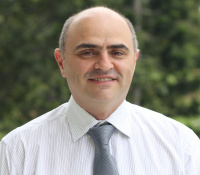Dr Farzad Bashirzadeh (Respiratory and Sleep Medicine Specialist)

- Name
- Dr Farzad Bashirzadeh
- Qualifications
- FRACP 2009
- MD Shahid Beheshti University 1994
- Occupation
- Respiratory and Sleep Medicine Specialist
- Gender
- Male
- Languages Spoken
- Farsi
- Turkish
- Azerbaijani
- Medical Specialties
- Respiratory and Sleep Medicine
- Phone
- 07 3871 0033
- Fax
- 07 3371 0522
Dr Farzad Bashirzadeh is a Respiratory and sleep Physician from Brisbane specialised in diagnosis and management of Lung Cancer, Asthma, Emphysema , Chronic obstructive pulmonary disease (COPD), Sleep disordered breathing, Chronic Cough, Sarcoidosis, Pleural disease and other respiratory conditions. Special interest area is pulmonary intervention, including Endobronchial valves for COPD, Endo-Bronchial Ultrasound, Trans-Bronchial Needle Aspiration and Lung Biopsy, medical thoracoscopy, Narrow Band Image (NBI) bronchoscopy, Diagnostic Auto-Fluorescence Endoscopy/Bronchoscopy (DAFE), bronchial stenting and endoscopic lung volume reduction.
- Hospital Affiliations
- Royal Brisbane and Women's Hospital
- St Andrew's War Memorial Hospital
- The Wesley Hospital
- Affiliated Clinics
- Queensland Respiratory and Sleep
- Queensland Respiratory and Sleep - Spring Hill
- Queensland Respiratory and Sleep - Hervey Bay
- Queensland Respiratory and Sleep - Rockhampton
- Affiliated Organisations
- GenesisCare Centre for sleep medicine
- Queensland Respiratory Services (QRS)
- The Royal Australasian College of Physicians (RACP)
- Affiliated Universities
- University of Queensland
- Medical Conditions
- Lung cancer
- Chronic obstructive pulmonary disease
- Emphysema
- Asthma
- Chronic Cough
- Sleep disorder
- Tuberculosis
- Occupational lung disease
- Medical Interventions
- Endobronchial ultrasound (EBUS)
- Transbronchial needle aspiration (TBNA)
- Endobronchial ultrasound-guided transbronchial needle aspiration (EBUS TBNA)
- Endobronchial valve
- Lung Biopsy
- Thoracoscopy
- Narrow Band Image (NBI) bronchoscopy
- Diagnostic Auto-Fluorescence Endoscopy/Bronchoscopy (DAFE)
- Bronchial Stenting
- Endoscopic lung volume reduction
- Bronchoscopy
- Bronchial thermoplasty
- Topics
- Interventional Pulmonology
Social Media
|
|
http://www.linkedin.com/pub/farzad-bashirzadeh/16/127/77b |
|---|
Practice Locations
Brisbane
- Queensland Respiratory and Sleep
- Address
- Wesley Medical Centre
Suite 24 Level 2
40 Chasely Street
Auchenflower QLD 4066
Australia
- Phone
- 07 3371 0500
- Fax
- 07 3371 0522
- Queensland Respiratory and Sleep - Spring Hill
- Address
- St Andrew’s War Memorial Hospital
457 Wickham Terrace
Spring Hill QLD 4000
Australia
- Phone
- 07 3371 0500
- Fax
- 07 3371 0522
Hervey Bay
- Queensland Respiratory and Sleep - Hervey Bay
- Address
- St Stephen’s Hospital Hervey Bay
1 Medical Place
Urraween QLD 4655
Australia
- Phone
- 07 5322 5904
- Fax
- 07 5322 5905
Rockhampton
- Queensland Respiratory and Sleep - Rockhampton
- Address
- Mater Misericordiae Hospital Rockhampton
Oncology & Cardiology Suite 1, Level 1
31 Ward Street
Rockhampton QLD 4700
Australia
- Phone
- 07 3371 0500
- Fax
- 07 3371 0522
Publications
- Grey scale texture analysis of endobronchial ultrasound mini probe images for prediction of benign or malignant aetiology. Respirology 2015;20:960-6. http://www.ncbi.nlm.nih.gov/pubmed/26113224 Abstract: Expert analysis of endobronchial ultrasound mini probe (EBUS-MP) images has established subjective criteria for discriminating benign and malignant disease. Minimal data are available for objective analysis of these images. The aim of this study was to determine if greyscale texture analysis could differentiate between benign and malignant lung lesions.
- Comparison of objective criteria and expert visual interpretation to classify benign and malignant hilar and mediastinal nodes on 18-F FDG PET/CT. Respirology 2015;20:129-37. http://www.ncbi.nlm.nih.gov/pubmed/25263085 Abstract: There is widespread adoption of FDG-PET/CT in staging of lung cancer, but no universally accepted criteria for classifying thoracic nodes as malignant. Previous studies show high negative predictive values, but reporting criteria and positive predictive values varies. Using Endobronchial ultrasound transbronchial needle aspiration (EBUS-TBNA) results as gold standard, we evaluated objective FDG-PET/CT criteria for interpreting mediastinal and hilar nodes and compared this to expert visual interpretation (EVI).